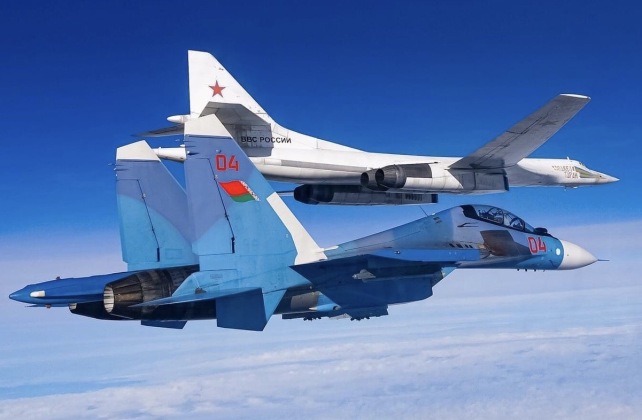The Belarusian Air Force deployed a Su-30SM fighter for a snap combat readiness drill, according to a report from the country’s defence ministry on June 26. The crew performed “a timely takeoff, assumed an assigned patrol zone in the airspace and was then inspected fulfilling an objective of air defence quick reaction alert forces,” according to the ministry’s report. This represented part of broader surprise combat readiness inspections across the armed forces which began on June 21, and included ground force training operations in forests and marshlands as well as the use of drones and electronic warfare assets. As Russia’s only security partner in Europe, Belarus has faced growing tensions with the Western Bloc and perceived a growing threat from the major buildup of NATO forces in Eastern Europe, including the rapid modernisation of the Polish Armed Forces primarily through ground equipment acquisitions from South Korea and F-35 stealth fighter purchases from the United States. Relations between Belarus and the Western world worsened in 2020 after Minsk alleged Western support for major protests and riots that threatened to overthrow the government, and further deteriorated following the outbreak of open war between its security partner Russia and Western and Ukrainian forces in February 2022.
The Belarusian Air Force selected the Su-30SM as a successor to the MiG-29 as its primary fighter class, with the new aircraft representing by far the heaviest and longest ranged in Europe with the largest radar size. The aircraft’s considerably higher operational costs than the MiG-29, however, mean that they are not likely to be acquired in comparable numbers, with the fleet size expected to contract by around one third to eventually accommodate around two dozen Su-30SMs. The choice of the Su-30 over a similarly sized counterpart to the MiG-29, such as the MiG-29M or MiG-35, is thought to have been influenced by two primary factors including the perceived greater cost effectiveness of the larger more capable aircraft, and the need for maximum compatibility with frontline Russian Air Force units, which are almost all comprised of the Su-30SM or heavier aircraft such as the Su-34 or MiG-31. Four Su-30SMs are currently in service in the Belarusian Air Force, with eight more on order and a followup order for 12 more speculated.

The Su-30SM is a close derivative of the Su-30MKI developed for the Indian Air Force, which merged the capabilities of the original Su-30 long range interceptor with technologies from the cancelled Su-27M and Su-37 air superiority fighters, which had been too expensive for the Russian fleet. This included use of the Su-37’s NO11M radar – one of the first ever electronically scanned array radars integrated onto a fighter – as well as the Su-35’s controlled canards, AL-31FP engines and thrust vectoring nozzles. The fighter quickly demonstrated comfortable capability advantages over competitors such as the British Eurofighter and American F-15 during simulated combat exercises. The Su-30SM built on these capabilities with greater use of indigenous Russian subsystems, and with integration of the much more advanced N011M Bars radar with a 400km maximum detection range and 200km search range. It also integrated a wide angle heads up display, new identification friend or foe and communications systems, and compatibility with the SAP-518 jamming pod. The aircraft is compatible with a range of advanced munitions including the R-37M long range air to air missile, which has proven highly potent in the Ukrainian theatre, and will in future reportedly gain compatibility with the Kh-32 anti ship cruise missile.
